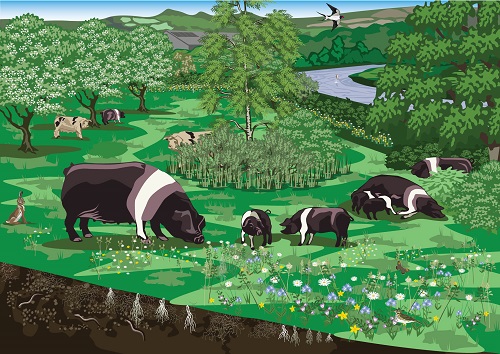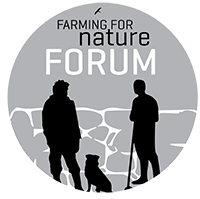PIG
Here are some practical ways to take climate action and enhance biodiversity on your pig farm
Climate & Biodiversity actions full doc (pdf)
Pig section only (pdf)
1. Energy & fuel
Maximising energy efficiency and moving away from fossil fuels are two ways in which pig farms can minimise their carbon footprint.
- Consider renewable energy – a shed roof can be the ideal place to install solar panels and supports are increasingly available
- Improve building insulation and ventilation – being able to effectively control internal temperature can lead to less energy wastage
- Mend leaky pipes and troughs – drinking water production and supply requires energy yet >43% of treated drinking water in Ireland is lost to leaks
- Choose suppliers that minimise plastic packaging – plastics are produced using fossil fuels
- Consider less intensive management systems – pasture-based systems can reduce energy costs
- Turn off the lights! – utilise natural light where possible and LED bulbs when artificial light is necessary
- In intensive farrowing systems, use heated creep boxes or heat pads to reduce the need to heat the entire farrowing house
- Reduce emissions from the transport of feed by growing feed crops on farm
Co-benefits for farmers
- Reduced fuel and input costs
- Reduced energy costs
- Improved farm self-sufficiency and climate resilience
- Increased resilience to market forces (feed & fertiliser costs)
- Increased animal welfare and market price
2. Trees, scrub & hedgerows
Woody vegetation captures and stores carbon.
- Where possible, plant native trees around the production areas, driveways, sheds and farmyard
- In pasture-based systems, allow for natural regeneration of trees and scrub in less productive areas
- Plant native hedgerows
- Allow existing hedgerows to grow tall and wide
- Experiment with agroforestry/silvopasture to build a climate resilient farm system
- Diversify farm enterprises by planting a native woodland
- Retain, enhance or create woodland areas, copses and scrubland
Co-benefits for farmers
In a pig farming system woody vegetation can:
- provide enrichment
- provide shade & shelter
- improve animal welfare
- enhance biodiversity
- diversify farm enterprises
- create a positive working environment
3. Soil
Healthy soils capture carbon.
Pasture-based systems can use less energy than indoor systems, however, it is important to also consider the impacts of outdoor pigs on soil erosion – one happily rootling pig can ‘plough’ acres of land in a single wet winter!!
- Healthy, undisturbed soils store carbon – retain soil carbon by minimising ploughing and reseeds
- Carefully design wallows and shaded areas to avoid excessive poaching and pinch points
- Maximise the outdoor season to minimise the need for imported feed – our use of imported feeds is contributing to rapid destruction of the rainforest in Brazil
- Plant species-rich swards to naturally fix nitrogen, improve drainage and build flood and drought tolerance
- Reduce grassland management intensity to allow sward diversity to develop naturally
- Avoid compacting your pasture through overstocking or with increasingly heavy farm machinery
- If growing your own feedstuffs, consider no- or min-till and the use of multi- and cover-crops
- Choose breeds wisely – traditional (habitat adapted) breeds (often now associated with artisan meat production) can require less inputs in pasture based systems
- Rent out a pig! – while too much rootling can be destructive to soils, pig rootling can be a valuable conservation tool where natural soil disturbance is desirable (e.g. to break up areas of dense bracken to plant trees); some farmers are renting out their pigs for this purpose!
Co-benefits for farmers
Healthy soil:
- increases yields
- has a higher level of available nutrients for forage crops (meaning less fertilizer is used)
- is easier to cultivate (meaning less diesel is used)
- retains more moisture (making crops more drought tolerant)
- drains better (making land more flood resistant)
- supports more soil microbes (which in turn store more carbon and lead to even healthier soils).
“A healthy soil in any farming system is like a nice three legged stool, good soil physical structure, buzzing soil biology and chemical activity that draws minerals to make your plants thrive (…) by building your soil health and the nature value on the farm through good hedgerow management also, (farmers) are securing themselves from the future hits of Climate Change, Biodiversity Loss and Water Quality issues.” Sean O’Farrell, Mixed-stock (pigs, poultry, cattle, goats) farmer & FFN Ambassador, Co. Tipperary.
4. Nutrient management
A nutrient management plan can help you to both improve efficiency and reduce emissions from pig slurry and other nutrients.
- Treat your pig slurry with respect! – pig slurry is an increasingly valuable farm asset, store it carefully and make sure it doesn’t get wasted!
- A slight reduction in stocking rate could take the pressure off in terms of pig slurry storage
- In outdoor systems, retain, enhance and create buffer strips and hedgerows to help prevent nutrient run-off
- Maximise nutrient uptake by crops by maintaining optimum soil pH
- Where possible, use low emissions slurry spreading
- To maximise nutrient absorption, spread fertiliser, slurry and farmyard manure on warmer days (soil temp at least 6°C)
- Include nitrogen fixing legumes in swards or feed crops (e.g. clover, vetch, beans)
- If fertilising feed crops, switch CAN for protected urea
- Mobile phone operated GPSs and tractor sensors can help to maximise nutrient uptake through more targeted spreading
Co-benefits for farmers
- Maximising use of a valuable asset
- Decreased fertiliser use (lower costs)
- Increased farm self-sufficiency (lower external inputs)
- Decreased vulnerability to market forces
5. Water management
Our water bodies (rivers, lakes and oceans) naturally work together to support biodiversity and to store carbon. When water bodies are polluted, these systems break down. Almost half of Irish surface waters are not in good health and the situation is deteriorating. Help to restore our water bodies by eliminating harmful farm run-off:
- List the potential sources of run-off from your farm and how you might eliminate them. Some of these (e.g. pig manure) are more obvious than others (e.g. spoil from tractor tyres, washings or waste feed)
- Keep clean run-off e.g. (from shed roofs and clean paved areas) separate from soiled water, washings and slurry
- Spread soiled water in dry fields far from water-courses
- In outdoor systems, fence pigs well back from watercourses; don’t allow stock to drink directly from rivers; avoid poaching and pinch points
- Reduce nutrient run-off from pasture: plant buffer strips, field margins and hedgerows to slow the flow of nutrients; create a wetland to soak up and filter excess run-off after heavy rain
- Never spread or spray inputs when rain is due
- Treat your chemicals with respect – just one drop of pesticide can pollute a small stream for over 30kms!!
- Reduce herbicide use by using alternative methods of weed control e.g. non-synthetic herbicides, topping, diverse crop rotations. As many synthetic herbicides are water soluble (e.g. MCPA, 2,4-D), it is almost impossible to ensure they do not end up in watercourses after application.
Co-benefits for farmers:
- Reduced input, labour, fuel and machinery costs
- Cleaner water and good health – research has detected herbicides in 38% of drinking water wells tested in Ireland.
- Habitats – cleaner water benefits humans and nature alike
Curious? Have you run the numbers for a reduced stocking rate or for going organic?
Reduced stocking rates: with the current shift in farm payments away from production and towards environmental measures, could reducing the intensity of your farming system now make sense from both climate and financial perspectives?
Going organic: Have you run the numbers for going organic? New supports and a growing market are making this an increasingly attractive option for pig farmers.
Nature co-benefits
Climate action on pig farms can benefit nature by creating:
- More species-rich and diverse landscapes, supporting native fungi, insects, birds, mammals and more!
- Healthier rivers, lakes, estuaries and oceans, rich with life
- Habitat for our native species to feed and breed
- Nature-rich farms – loud with humming insects and singing birds
- A model for other pig farmers; when we experience nature on another farm we are more likely to want to protect it on our own!
Nothing beats nature for providing natural climate change adaptation and mitigation. Boosting biodiversity, from the soil to the treetops, will help your farming system to remain productive and resilient in the face of increasingly unpredictable weather events.


